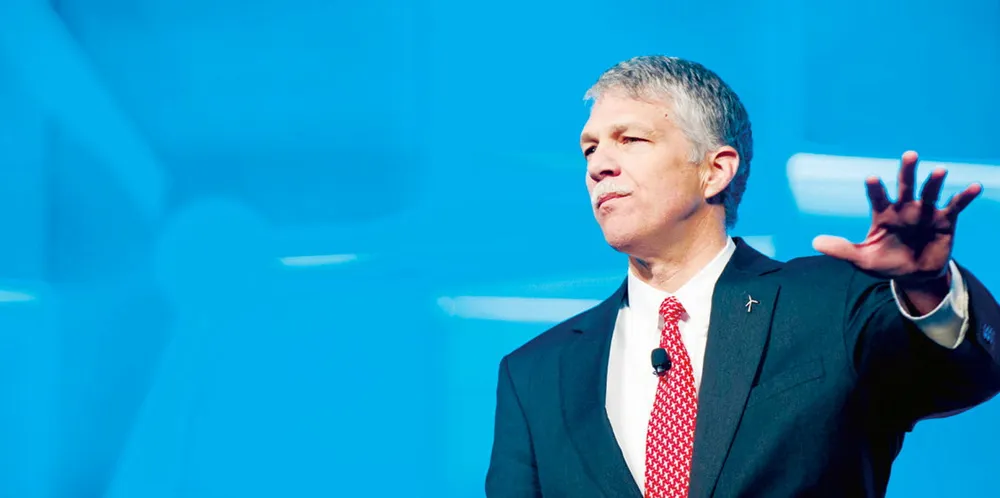US Congress will back tax breaks for clean-energy but not Biden's bigger climate plan: AWEA boss
Credits for offshore wind power and standalone energy storage will join wind and solar under the President-elect's energy transition strategy, expects Tom Kiernan

The next US Congress will extend federal wind and solar tax credits and likely enact one for standalone energy storage – but is unlikely to support big national climate-related strategies if opposition Republicans retain Senate control, believes Tom Kiernan, CEO of the American Wind Energy Association (AWEA).
Green is the new black. Subscribe to Accelerate
Get the market insight you need into the global oil & gas industry's energy transition – from the new newsletter from Upstream and Recharge. Sign up here
“I think tax credits will continue as an important component of clean energy in the US,” he said in an interview on WindTV during the WindEnergy Hamburg online industry conference, noting that President-elect Joe Biden wants the credits extended and the renewables industry has a track record of gaining bipartisan support for them.
In the Senate, Republicans hold a 50-48 edge. Run-off elections on 5 January in the state of Georgia will determine if two Republicans there can hold their seats.
In late 2015, Congress approved a multi-year extension of the wind production tax credit (PTC) and solar investment tax credit (ITC) with the stipulation the PTC would expire at the end of 2019 and the 30% ITC would begin to step down this year to a permanent 10% for commercial-scale projects only in 2022.
That move ignited record installations at utility-scale, enabling wind and solar to double their combined share of the US electricity mix to above 10%.
Last year, lawmakers surprised the wind industry by renewing the PTC – first enacted in 1992 – through to 2020 while keeping the solar ITC phase down schedule. An eligible wind project that starts construction this year can claim the credit worth $14.40/MWh for electricity sent to the grid in its first decade of operation.
In lieu of the PTC, they also allowed offshore wind projects that begin construction to qualify for the ITC. Developers prefer the ITC – a one-time, up-front benefit worth 18% of capital expenditure – given the larger investments and longer development cycles that offshore projects require.
Kiernan believes that Biden will support direct ITC eligibility again for offshore wind which lapsed in 2019. “I think there is a strong understanding in Congress that it’s appropriate to have a tax credit with the industry still in the early stages and that has huge potential,” Kiernan said, adding: “We’re looking at 80,000 new jobs in the coming decade.”
He emphasised the importance of the wind and solar industries having “some type of parity” across tax credits with other energy sources. Fossil fuels, for instance, continue to enjoy widespread incentives embedded in the federal tax code since last century whereas the PTC and ITC, the main support mechanisms for renewables, periodically expire and require renewal.
Wind and solar trade groups such as AWEA and the Solar Energy Industries Association (SEIA) are urging the incoming administration to approve a direct pay or cash grant option for the PTC and ITC, given ongoing weakness in the $15bn tax equity market.
Some developers are having trouble raising tax equity, which underpins a large chunk of renewables investment, particularly those with less capital or with perceived or real issues involving off-take creditworthiness. Some projects are getting pushed into 2021 or are on hold.
Banks are the main tax equity investors, but large load loss provisions because of Covid-19 financial impacts and tax carry-forwards have made it difficult for their tax forecasters. Some banks have retreated from the market while others are focusing on investing tax equity mostly in projects owned by longstanding project developer clients.
Tax equity is expensive, however. The largest and strongest project developers contend that capital cost declines and technology improvements will continue to significantly improve wind and solar economics versus alternative fuels, making the PTC and ITC unnecessary.
Energy storage will further enable wind and solar to compete as battery costs decline along with efficiency improvements in response to engineering innovation and technology improvements.
At present, an energy storage system can qualify for the ITC only if it is installed at the same time as a solar or wind energy facility or system. Kiernan and other renewables leaders want standalone storage ITC eligibility for large-scale projects, a move they argue would create steady long-term demand for wind and solar.
Elsewhere, Kiernan said a Republican-Senate under Majority Leader Mitch McConnell of Kentucky, a major coal state, is unlikely to support big climate initiatives such as a national carbon tax or a clean-energy standard tied to a cap-and-trade programme, should Biden promote them.
Instead, the AWEA chief expects Biden to pursue a multi-pronged approach starting with formation of a National Climate Council or similar body to help direct the administration’s domestic climate policies. The executive branch will play a critical role in making climate a core consideration of decision-making throughout the federal government.
The Environmental Protection Agency will play a big part through administrative actions and rulemaking, as will the Departments of Energy and Interior and likely Transportation. Biden could also ban hydraulic fracturing on public lands.